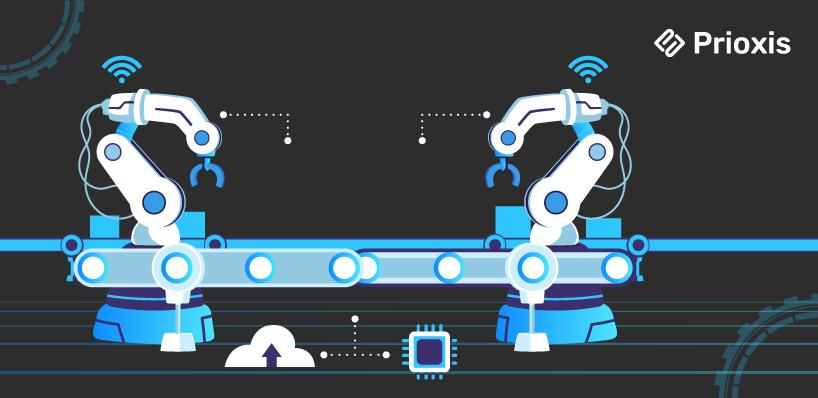Top 10 Robotic Process Automation Best Practices
 Admin
Admin Digital Transformation
Digital Transformation Sep 20, 2024
Sep 20, 2024

Table of Content
Before jumping into best practices for RPA, it's important to understand what it can really do for your business. RPA is an automation methodology that handles repetitive tasks—things like data entry, processing invoices, or generating reports for compliance. It's not designed to think or make complex decisions like a human or artificial intelligence, but that's not its purpose. By automating these routine tasks, RPA gives your team more time to focus on the bigger picture—like driving business growth, improving customer experiences, or tackling strategic projects. This can lead to a boost in productivity and even spark new ideas and innovation across your business.
The benefits of RPA—cost savings, enhanced productivity, and faster processes—are compelling. However, implementing RPA successfully requires careful planning, training, and governance.
Here are 10 practical, business-relevant best practices, along with explanations that show how they can work for your business. This will help decision-makers understand the potential of RPA and how to maximize its benefits. Let's understand deeply about RPA implementation guide & its best practices.
RPA Best Practices: Let's Put RPA Bots at Work
1. Start Small & Scale Gradually
Start by automating a few simple, high-impact processes before expanding to more complex ones.
For example, let’s say your business manually processes hundreds of invoices every week. By using RPA to automate this process, you can start with a specific department, like finance, where repetitive tasks are common. After successfully automating invoice processing, you can measure results such as faster processing times, reduced errors, and cost savings. Once this initial success is clear, you can expand RPA to other areas such as procurement or HR for automating document approvals, employee onboarding, or payroll processes.
How It Helps Your Business
For a USA-based mid-sized enterprise, beginning with small automation projects will help secure quick wins. For example, automating repetitive financial tasks can reduce human error, improve processing speed, and ensure better compliance with regulatory standards, all of which are crucial for scaling the automation initiative across the company. You can then build on these early successes to scale automation across departments.
2. Focus on Business Results
Always measure RPA success by business outcomes, not technical metrics.
In any business, the goal of RPA should be improving business efficiency and generating measurable returns. Before implementing an RPA solution, set clear goals—such as reducing operational costs by 20%, improving compliance rates, or speeding up customer service by 30%. Track key performance indicators (KPIs) that directly tie to your business goals. For instance, automating customer service queries through RPA could lead to faster response times and improved customer satisfaction, which ultimately drives revenue growth.
How It Helps Your Business
If you are running a service-based company, focus on reducing response times to client queries. RPA can automate responses to common inquiries, allowing human agents to focus on more complex issues. The result? Improved customer satisfaction and lower operating costs—business outcomes that matter for growth.
3. Prioritize Governance
Establish a strong governance structure to manage the lifecycle of RPA—from development to deployment and maintenance.
Without proper governance, RPA initiatives can spiral into inefficiency and security risks. Start by assigning clear roles and responsibilities, such as designating an RPA Center of Excellence (CoE) within your organization. This team would be responsible for creating rules, standards, and controls that ensure all automation processes align with business goals, maintain security standards, and can be scaled across the organization.
How It Helps Your Business
If your business is in a highly regulated industry, such as financial services, RPA governance can ensure compliance with industry standards and legal requirements. For example, automating credit risk assessments or customer onboarding requires strict control over data security and operational compliance. A governance framework ensures that these bots operate within the rules and adapt to regulatory changes without causing disruptions.
4. Invest in Employee Training
Offer training for both technical and non-technical staff to increase understanding and support for RPA initiatives.
RPA adoption should not only focus on the technical teams. Non-technical staff, especially those working directly with the processes being automated, need to understand how RPA will impact their daily work. Training employees on RPA’s benefits and operations will help foster buy-in and smooth the transition to a more automated workplace. It also lets your team identify potential automation opportunities within their workflows.
How It Helps Your Business
In a medium-sized business with limited IT resources, equipping employees from other departments with RPA skills can help streamline operations without burdening the IT team. For instance, customer service agents could learn how to leverage RPA tools to automate repetitive ticketing tasks, leading to faster resolutions and reduced workloads for IT staff.
5. Use Both Attended & Unattended Bots
Balance the use of attended bots (which work alongside employees) and unattended bots (which operate independently).
Attended bots are ideal for tasks that require some level of human intervention, such as processing customer inquiries. Unattended bots can operate without any human interaction, running 24/7 on tasks like generating reports or conducting routine data entry. By using both types, your business can optimize processes for both real-time human-robot collaboration and full automation.
How It Helps Your Business
For RPA in healthcare, the bots can assist staff in managing patient scheduling, while unattended bots could handle back-office tasks such as insurance claims processing. This dual approach improves efficiency across the board and allows your employees to focus on providing better patient care.
6. Design Resilient, Self-Healing Bots
Create bots that are resilient to changes in processes and capable of handling errors.
One of the main challenges businesses face with RPA is bots failing due to minor process changes. By designing bots with error-handling capabilities—such as retry mechanisms or fallback processes—your automation will be more reliable. Ensure your bots can alert you when they encounter issues and are built to recover from minor failures without needing constant human intervention.
How It Helps Your Business
If you’re running an eCommerce business, automating inventory management could involve integrating your RPA solution with external supplier systems. Any changes in the supplier’s data structure could cause bots to fail. By incorporating self-healing capabilities, your bots can adapt to these changes and maintain inventory records without interrupting the supply chain.
7. Integrate RPA with Other Technologies
Combine RPA with other advanced technologies, such as artificial intelligence (AI) and machine learning (ML), to unlock more sophisticated automation.
Integrating RPA with AI/ML tools lets your business automate more complex tasks, like analyzing unstructured data or making predictive decisions. This creates smarter workflows, where bots not only handle routine tasks but also support decision-making. For example, an AI-enhanced bot could analyze customer complaints and recommend improvements based on recurring issues.
How It Helps Your Business
In the insurance sector, integrating RPA with AI could automate claims processing by first scanning and extracting data from claim forms using optical character recognition (OCR) and then validating claims using AI models. This would speed up the entire claims process, reduce manual effort, and enhance accuracy.
8. Focus on User Experience and Adoption
Ensure that RPA bots are user-friendly and integrate smoothly into existing workflows to encourage employee adoption.
User experience is key to ensuring employees embrace RPA. Simple, intuitive bot interfaces that don’t require much technical knowledge will help users quickly adopt automation. Collecting employee feedback during design and testing ensures that bots are useful and relevant to their needs.
How It Helps Your Business
In a retail business, automating stock management and integrating the bot interface into the existing point-of-sale system will make it easier for employees to check stock levels in real time. This seamless integration ensures higher adoption rates and better overall user satisfaction.
9. Technical Oversight & Support
Provide IT teams with the tools and visibility they need to monitor and support bots.
For RPA to be effective long-term, IT teams must have full visibility into how bots are performing. Implementing monitoring dashboards and alert systems helps ensure that bots run efficiently, and any issues are quickly resolved.
How It Helps Your Business
In a logistics company, having IT support in place to monitor bots managing shipment tracking and inventory updates ensures that any disruptions are identified immediately. By providing real-time insights into bot performance, your IT team can act fast to resolve issues, minimizing business disruption.
10. Select the Right RPA Technology
Choose an RPA platform that fits your company’s needs and long-term goals.
Not all RPA platforms are created equal. Look for tools that offer easy-to-use, low-code interfaces and built-in management features, such as centralized control over bot activities. Consult with RPA solutions provider to understand how automation will help your operations, where it is needed the most and where you can avoid it. This helps your business quickly scale its automation efforts without heavy investment in custom development or IT resources.
How It Helps Your Business
For a mid-sized company, selecting an RPA platform with low-code capabilities allows your business users to automate simple tasks themselves, without waiting on IT. This leads you to faster deployment and ensures that automation initiatives are driven by business needs.
Concluding Remarks
RPA can bring significant value to your business, but its success depends on how well you plan and manage its implementation of RPA process. By following these best practices, you can create a strong foundation for RPA that not only delivers immediate benefits but also scales your business’s needs.
If you’re ready to explore how RPA can transform your business, Prioxis offers tailored RPA solutions to help you achieve your automation goals. Contact us today to learn how we can help you get started with intelligent automation.
Get in touch

